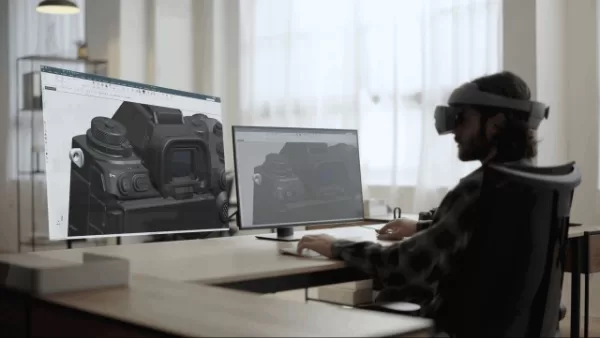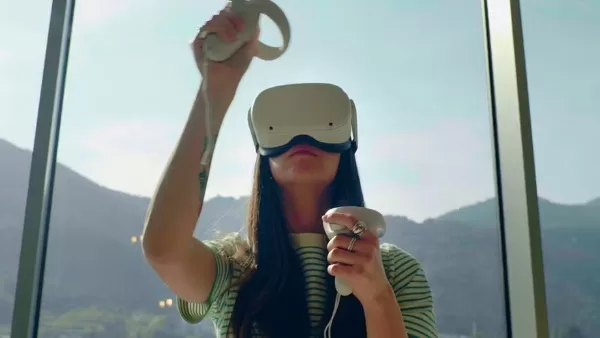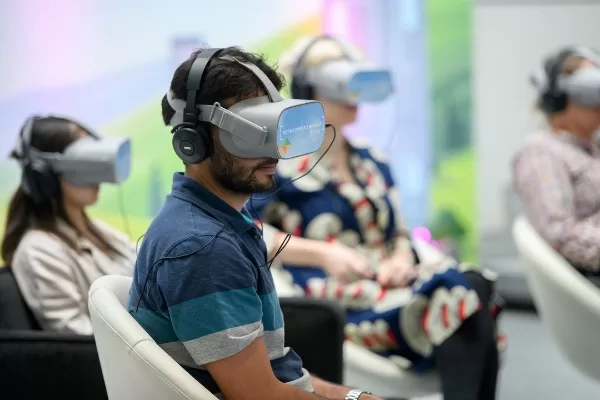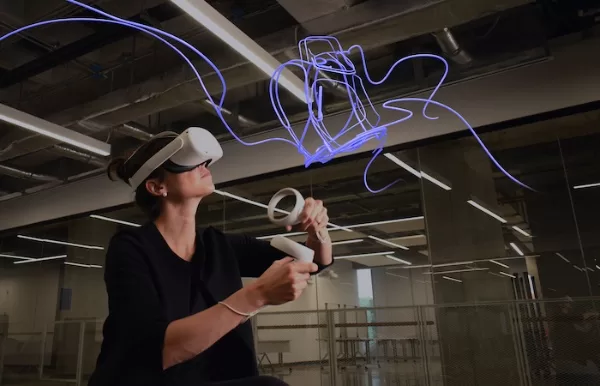Insights
What Is Immersive Design and How Can It Elevate Your Brand’s Experience?
On Digitals
02/09/2025
49
Immersive design is quickly becoming one of the most talked-about approaches in marketing, education, and user experience. At its core, immersive design is about creating experiences that go beyond traditional screens and pull people into interactive, engaging environments. Whether through virtual reality, augmented reality, or multi-sensory storytelling, immersive design helps brands and creators build deeper emotional connections with their audiences. In this article, we will explore what immersive design means, why it matters, and how businesses can start using it effectively.
Why Does Immersive Design Matter for Your Business Strategy?
People are drowning in content these days. Everyone’s fighting for attention in our digital-first world, and it’s getting harder to stand out. So instead of just throwing another piece of content at your audience and hoping for the best, immersive design actually invites them to participate.
This approach moves people away from mindlessly scrolling through screens and gets them actively involved in your brand experience. We’re talking about using voice, motion, AR, and VR to create interactions that feel natural and engaging.
What makes this so powerful for businesses? Well, when you create experiences that connect with people on multiple levels, they remember you and hitting multiple senses just stick better in people’s minds because it signifies investment. Safe to say, people love when creators go above and beyond when creating content and creating these emotionally driven interactions tend to build much stronger customer loyalty.

Why should immersive design be a mainstay in your strategy?
What Is Immersive Design, Exactly?
Who Coined the Term and What Does It Really Mean?
The term “immersive design” actually comes from Alex McDowell, who formulated it back in 2007. Originally, it was all about world-building and storytelling in film and entertainment. But like most good ideas, it’s evolved quite a bit since then.
Nowadays, it’s referred to as creating experiences where your audience isn’t just watching from the sidelines. They’re right there in the action, participating and engaging. Instead of focusing solely on what’s happening on screens, immersive design brings together motion, voice, VR, AR, and sensory elements to build environments that feel seamless and compelling. In other words, you transport users into an experience that feels natural, intuitive, and genuinely engaging.
What Makes Immersive Design Actually “Immersive”?
So what’s the secret sauce that makes immersive design work?
- Sensory engagement: This goes way beyond just looking at pretty visuals. We’re talking about incorporating sound, touch, and even spatial awareness to create richer, more memorable experiences.
- Interactive storytelling: Instead of your audience just sitting there consuming content, they get to influence what happens next. They’re shaping the story in ways that feel personal and meaningful.
- Technological finesse: The best immersive design experiences use AR, VR, mixed reality, and motion tracking in ways that feel completely natural. Nothing gimmicky or overwhelming, just smooth integration that enhances the experience would do.
- Narrative presence: Good immersive design creates a safe, emotionally compelling space where users genuinely feel like they’re part of the story. They form real connections with what’s happening.
When you combine all these elements, you transform an experience from something people watch into something they actually live through.

What constitutes the idea of immersive design?
How Should Marketers Design Immersive Experiences That Actually Work?
Principle #1: Be Crystal Clear on the “Why”
First things first, don’t just take up immersive design because it’s among the hottest things around. Before you dive headfirst into AR, VR, or any interactive tools, take a step back and clarify your purpose.
Ask yourself: Who exactly is this experience for? What do you want them to feel when they interact with it? What should they walk away with? How will you know if it’s actually working?
Once you’ve got your answers, you need to decide if the immersive approach is suitable for the message you want to deliver. Will it be overkill? Is your target audience interested in the innovative experience?
Principle #2: Blend Your Brand Story with Experience Design
Your immersive design should feel authentically you. These immersive elements need to amplify your brand story, not completely overshadow it.
Let’s say your brand is all about sustainability. Your immersive design should highlight that commitment through authentic, engaging experiences that align perfectly with your core message. It should feel like a natural extension of who you are as a brand.
Principle #3: Craft a Seamless Sensory Flow
The most effective immersive design weaves together visuals, sound, motion, and interaction so smoothly that it feels completely natural. If even one element feels jarring or out of sync, it can completely break the immersion. You want to create a flow where each sense supports the others and keeps users completely absorbed in what’s happening.
For instance, if your promotional campaign has something to do with rural areas and natural values, you can still use immersive technology. However, the main mission is to guide your audience through an authentic journey, not an innovative one, so make sure that your materials are accessible and not too demanding on the technical front.
Principle #4: Tell a Story Users Can Actually Influence
Immersive design really shines when people get to participate, you can tell by the rise of choose-your-own-adventure media. When people feel like their choices actually matter and influence what happens next, the experience becomes much more personal and memorable. They’re not just observers anymore; they’re active participants in your brand story.
That said, it’s a tall order for sure, because now you’re technically writing multiple stories while accounting for way more possibilities than just writing one concrete script. This requires a very consistent team effort from your creators, so the audience can enjoy a cohesive experience highlighted by the design.
Principle #5: Make It Social or Shared Where It Adds Value
Multi-user or collaborative elements can really heighten emotional connection and encourage people to spread the word about what they experienced. Think about multiplayer VR games or group learning simulations. These shared immersive design experiences often feel richer and more meaningful because people are connecting not just with your brand, but with each other through your brand.
Principle 6: Test, Iterate, and Keep It Fresh
It cannot be stressed how crucial iteration is for successful immersive design. You should be testing your experiences with real users, refining based on their feedback, and updating regularly to stay relevant.
Keeping your content fresh ensures users stay engaged over time instead of getting bored and moving on to the next shiny thing. Remember, immersive design is an ongoing process, not a one-and-done project.

What to know to utilize immersive design properly
Where Is Immersive Design Already Making Its Mark?
Education & Training: Virtual classrooms, which have been a thing for a hot while, especially in museums, where students can actually walk through ancient Rome, or role-play scenarios where employees can practice handling difficult customer situations. People get to practice skills in safe, engaging environments without any real-world consequences.
Healthcare & High-stakes fields: AR and VR are being used for medical training and actual procedures. Surgeons can rehearse complex operations over and over again, and emergency responders can prepare for high-pressure situations without putting anyone at risk. Pretty amazing when you think about it.
Retail & Marketing: This is where it’s at for us marketers. Brands are using immersive storytelling to build deeper customer loyalty. Customers may now be able to try on clothes in a virtual store from your living room, or exploring a brand’s entire history through an interactive digital exhibit. These immersive design experiences make shopping more engaging and way more memorable than just scrolling through product photos.
What Challenges Should You Know Before Diving In?
Like any powerful tool, immersive design comes with some challenges you’ll want to think through before jumping in headfirst, which you have already thought of a few.
First up is technical complexity and cost. Designing for AR, VR, or multi-sensory environments requires specialized talent, software, and sometimes expensive hardware. This makes it a much bigger commitment than your typical marketing campaigns.
Then there’s the risk of falling into the gimmick trap. If your immersive design experience lacks a strong story or clear purpose for users, the novelty wears off pretty quickly. People will be unimpressed, and you’ll have spent a lot of money on something that doesn’t move the needle.
Accessibility is another big consideration that you absolutely can’t overlook. Your experiences need to be designed inclusively so that people of different abilities can engage meaningfully, without getting fatigued or disoriented.
Finally, you’ve got scalability and longevity concerns. A great immersive design shouldn’t be a one-off event that you launch and forget about. It should be an evolving experience that you can update and refresh without losing its impact over time.

Potential barriers in using immersive design
FAQs About Immersive Design
What makes immersive design effective for brands?
It’s effective because it drives much deeper emotional connections than traditional marketing approaches. It enhances memory retention and strengthens brand recall in ways that regular ads just can’t match. When people actually feel something during an experience with your brand, they’re way more likely to remember it and take action.
How does immersive design differ from traditional UX or UI design?
Traditional UX and UI design are mostly screen-bound, focusing on predictable user flows and two-dimensional interactions. Immersive design completely expands those boundaries by inviting physical presence, multi-sensory input, and giving users narrative agency. Instead of just following a predetermined path, users can actually shape outcomes and influence what happens next.
What key questions should I ask before starting an immersive design project?
Before diving in, ask yourself these fundamental questions: Why are we doing this? Who exactly is it for? What specific outcome or metric will define success for us? These foundational questions keep your entire project focused and aligned with your actual business goals instead of just being a cool tech experiment.
Which industries benefit the most from immersive design?
Industries like education, healthcare, retail, and entertainment are already seeing huge benefits from immersive design. From simulated training environments and AR-assisted medical procedures to interactive brand storytelling, immersive design really shines wherever emotional engagement and memory retention matter most.
How can I measure the impact of immersive design?
You can measure impact through several key metrics: user engagement duration, emotional feedback, retention rates, and conversion metrics tied directly to the experience. Tracking how long people stay engaged, how they respond emotionally, and whether they come back for more gives you a clear picture of how effective your immersive design really is.
Give Your Audience Something New With Immersive Design
Immersive design allows you to blend storytelling, sensory engagement, and the right technology. Brands can stand out in our incredibly noisy digital space and deliver experiences that actually stick with people. This proves to be a worthwhile investment for businesses that want to stay ahead of the curve.
On Digitals makes it our mission to help brands translate their stories into impactful visuals and engaging interactions. Our creative design service combines strategy, artistry, and innovation to craft experiences that resonate with audiences and strengthen brand presence. Explore how our team can bring immersive design principles into your marketing strategy by visiting our creative design service page today.
NEWEST POSTS
- Small Business Branding – 4 Strategies To Boost Your Brand!
- A Complete Guide to Crafting a Powerful Personal Branding Statement That Stands Out
- Brand Identity Explained: Core Definition, Components, and Strategic Value
- Benefits Of Personal Branding – 8 Advantages You Must Know
- A Complete Guide to Effective Social Media Personal Branding for Modern Creators
Read more
